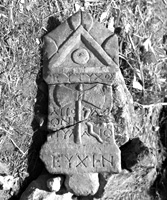 MAMA XI 30 (Eumeneia)
MAMA XI 30 (Eumeneia) 
Votive stele of Eutychos to Apollo Propylaios
- Type of monument:
- Votive stele.
- Location:
- Koçak (Eumeneia): in a house; said to have been found by children on the hill above the village.
- Description:
- Marble stele with pediment above and tenon below; broken into three pieces. In the pediment, circular boss; on the shaft, double-headed axe and snake in relief.
- Dimensions:
- Ht. 0.44; W. 0.185 (pediment), 0.15-16 (shaft), 0.195 (base); Th. 0.050-0.065; letters 0.015-0.026.
- Record:
- Line drawing; MB notebook copy; photograph (1956/47).
- Publication:
- None.
- Date:
- Roman imperial period.
Εὔτυχος
Ἀπόλλ̣-
ωνι [Προ]-
πυλαίῳ
5εὐχήν.
Eutychos, to Apollo Propylaios, in fulfillment of a vow.





For the cult of Apollo Propylaios at Eumeneia, see Labarre 2007. Six other votive dedications to Apollo Propylaios are known from Eumeneia, all carrying a double-axe in relief, see (1) Ramsay, Phrygia II 374, no. 195 (Koçak); (2) Tod 1904-5: 28-9, no. 1 (Işıklı); (3) Buckler, Calder and Cox 1926: 66, no. 187 (Balçıkhisar); (4) BE 1953, 129 (BE 1964, 277: Istanbul); (5) Drew-Bear 1976: 260-1, no. 15 (SEG 26, 1376; Petzl 1994: 120-1, no. 104: Koçak); (6) Drew-Bear 1978: 66-7, no. IV 1 (SEG 28, 1121: Işıklı). For a priest of Apollo Propylaios at Eumeneia, see Ramsay, Phrygia II 374-5, no. 196 (IGR IV 742: Işıklı). The god appears with a double-axe and raven on many of the coins of Eumeneia (Labarre 2007: 284-5, to which should be added the Hadrianic cistophori minted at Eumeneia: Metcalf 1980: 62-3). Labarre has argued that the chief sanctuary of Apollo Propylaios was situated within the urban centre of Eumeneia; however, it is striking that three of the seven known dedications to Apollo Propylaios derive from the village of Koçak, 6km due west of the site of Eumeneia (Işıklı).
The snake depicted on our relief also appears as an attribute of Apollo Propylaios on the pre-imperial coinage of Eumeneia (BMC Phrygia 212, nos. 12-19: tripod with double-axe encircled by a serpent) and on countermarks applied by the city in the Roman imperial period (Howgego 1985: 176, nos. 374-5: double-axe encircled by a serpent). That the deity possessed healing abilities is implied by one of the dedications from Eumeneia (Buckler, Calder and Cox 1926: 66, no. 187): εὐχαρ[ισ]τῶ σοι ὅτι τῆ[ς] πλε⟨υ⟩ρᾶς ἄπον[όν] με ἐτήρησε̣[ς].